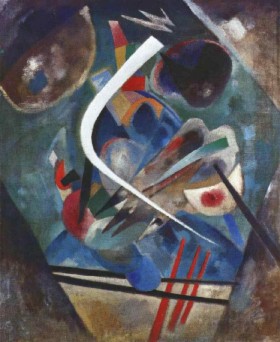The Most Modern Show on Earth!
John Haberin New York City
The Tradition of the New
Rolywholyover a Circus
From the outside, it has been easy to make fun of the enlarged Guggenheim museum. Let me be the last person (I hope) to point out that its tall, vertical slab looks like a toilet tank next to Frank Lloyd Wright's original inverted funnel.
Inside, the extra space has been put to good use. Wright's ramp still prevents the viewer from getting close enough to art, but it copes pretty well now with large work—or is it the other way around? And the museum's collection of early Cubism, Klee, Mondrian, and other modern artists, now given rectangular walls, at last looks as splendid as it deserves. I wonder if Wright, who believed that people should accommodate themselves to his houses, would care. 
As always, the ramp reduces art to a time line. However, the museum now has the sense to begin shows at the bottom. Visitors can take art in more slowly, feel less like creatures on an assembly line, and have the chance to reassess what they have seen when they walk back down. There is even a great terrace view across Central Park.
Masterpiece theater
Summers are often the best time to sample a museum's regular collection, and right now the rotunda is displaying some of the postwar works it handles best. So it is only fair to report on exactly what you will and will not see.
Postwar selections lean to painting and conceptual art. They move from a small Pollock and Andy Warhol electric chairs through a brushy white painting by Robert Ryman. The museum's unusually full collection of Minimalism is less in evidence, and tower rooms off to the side offer virtually no prewar painting.
The European selections can get a little tedious, too. I could have done without all those throwbacks to the 1970s, with the decade's fascination for German mock expressionism. Yet the works from Europe also include some terrific surprises. Black vertical stripes and blurred clouds by Gerhard Richter play thrillingly with color-field abstraction, slickly mirrored surfaces, and photographic negatives—even more so in Richter's late work.
Even the show's title stands as a disquieting reminder of the museum's conservatism. The word war needs no explanation. (Hint: it is not Vietnam or the culture wars.) And selections are, to be sure, masterpieces. Still, visitors have to take what they can get, and they should. No single show can do it all, and an effective antidote to this one's sobriety is supplied by the Guggenheim itself, at the museum's Soho branch.
Taking chances
More of the collection is on display downtown, including most of its Kandinskys. The real reason to go down, however, is the second floor. The display may not be as quirky spatially as up in the rotunda, but it constantly changes in time, like an intensification of the day-to-day shifts in a Richard Tuttle retrospective. In memory of John Cage, works rotate on and off the walls right as we watch, according to a random pattern. A computer is supposed to take into account the I Ching, space on the museum walls, the size of each work, and for all I know my latest 1040. Readings and other events occur in "chance-determined time brackets."
In Cage's music, this sort of rationale can seem precious, and yet the sounds remain airy and unintimidating. For Stanley Cavell, it also still challenges anyone to call it art. The show has much the same effect. One is set free to wander among the art objects. One can see why so many artists, such as James Rosenquist, admired him.
I could open drawers at a whim to see the books hidden inside. I could check a computer database of late modern music. I could talk to the people managing the changing installation and watch what other idiots like myself were doing. The selection of paintings and drawings has no more weighty justification than one man's tastes, but that sure satisfied me. Admirers of Cage and his prepared piano works will not be dismayed to see a Jasper Johns map painting, as well as a chess board with pieces set for mate. The pairing notwithstanding, this is decidedly not as for Johns art as the classic still life!
The impermanent collection
I wanted to feel that the uptown branch stood firmly for Modernism, while Soho opened onto a newer video age. Yet both were memorials of a kind. It shows quite as much in the inclusion of Johns, the prefect modernist, as in the remembrance of Cage himself. For true alternative spaces in the tradition of P.S. 1 one must look elsewhere. Perhaps a similar queasiness should take over when Yoko Ono and her hypothetical art shows on 57th Street or Marcel Duchamp enters the museums.
It could hardly be otherwise. One knows where an era begins, but only in retrospect. Can one ever know when it ends? Part of the contradiction within Modernism and Postmodernism is that the past never ceases to matter, and that is exactly why both remain so moving. Like Cage himself, just when one decides they have become clichés, they inject a new element of chance into the decision.
Think back to those random choices in Soho. As art shifts right on the wall, time appears to move supernaturally fast, and yet time and the museum institution become fragmented. By the time I left, the phrase "permanent collection" seemed a lot less redundant and a lot more like a contradiction in terms. For a moment, I even wished that the shows uptown still began at the top of the ramp, so that I could one last time walk defiantly up.

"The Tradition of The New" ran through September 7, 1994, at The Solomon R. Guggenheim Museum. "Rolywholyover a Circus" ran through July 31, 1994, at The Guggenheim Museum Soho.




